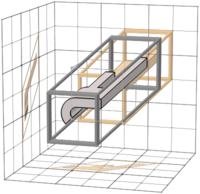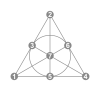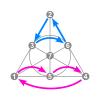3-bit Walsh permutation
| Walsh permutation |
There are ![]() A002884(3) = 4 * 6 * 7 = 168 invertible binary 3×3 matrices.
A002884(3) = 4 * 6 * 7 = 168 invertible binary 3×3 matrices.
They form the general linear group GL(3,2). (As all non-zero determinants are 1 in the binary field, it is also the special linear group.)
It is isomorphic to the projective special linear group PSL(2,7), the symmetry group of the Fano plane.
Each of these maps corresponds to a permutation of seven elements, which can be seen as a collineation of the Fano plane.
| six edge cases of invertibility | ||||||||||||||
|---|---|---|---|---|---|---|---|---|---|---|---|---|---|---|
|
To be precise, the group consists of the 168 binary matrices whose inverses are integer matrices, namely with entries 0, 1 and −1.
The following Python script shows that the 512 binary matrices consist of 338 singular matrices, 168 with integer inverses and 6 with non-integer inverses: from itertools import product
def is_integer_matrix(matrix):
for row in matrix:
for entry in row:
if entry % 1 > 0:
return False
return True
number_of_singular_matrices = 0
number_of_matrices_with_integer_inverses = 0
number_of_matrices_with_non_integer_inverses = 0
for m00, m01, m02, m10, m11, m12, m20, m21, m22 in product([0, 1], repeat=9):
mat = np.array([[m00, m01, m02], [m10, m11, m12], [m20, m21, m22]])
try:
mat_inv = np.linalg.inv(mat)
if is_integer_matrix(mat_inv):
number_of_matrices_with_integer_inverses += 1
else:
number_of_matrices_with_non_integer_inverses += 1
except np.linalg.LinAlgError:
number_of_singular_matrices += 1
print('singular matrices:', number_of_singular_matrices)
print('matrices with integer inverses:', number_of_matrices_with_integer_inverses)
print('matrices with non-integer inverses:', number_of_matrices_with_non_integer_inverses)
|
Representations[edit | edit source]
| overview | |||||
|---|---|---|---|---|---|
|
These images show the connection between the 3×3 matrices and the permutations:
|
| permuted Walsh matrices | |||||
|---|---|---|---|---|---|
|
These images show why the author chose the term Walsh permutation.
|
| transformations (letter compound) | ||||||||||||
|---|---|---|---|---|---|---|---|---|---|---|---|---|
|
Here the binary 3×3 matrices are used as transformation matrices. A list of these files can be found here.
|
| transformations (colored cube) | ||||||||||||
|---|---|---|---|---|---|---|---|---|---|---|---|---|
|
These images show the connection between transforms and permutations:
|
| cube with RGB vertices and complement patterns | |||||
|---|---|---|---|---|---|
|
The colors are in the same vertices of the gray cube as in the transform images above.
|
Conjugacy classes[edit | edit source]
The group has ![]() A006951(3) = 6 conjugacy classes. They almost correspond to the cycle type,
A006951(3) = 6 conjugacy classes. They almost correspond to the cycle type,
but there are two different conjugacy classes with 7-cycles.
(For the distinction between them, see here.)
The permutations in 2+2 are self-inverse, and their fixed points correspond to Walsh functions. They can be found here.
| more examples | ||||||
|---|---|---|---|---|---|---|
| description | neutral | 2+2 | 2+4 | 3+3 | 7a | 7b |
| size | 1 | 21 | 42 | 56 | 24 | 24 |
| examples | ||||||
The 3×3 matrices in the same conjugacy class are similar.
| examples of matrix similarity | |||||
|---|---|---|---|---|---|
| matrix multiplication | |||||

| |||||

| |||||

| |||||

| |||||
Cycle shapes [edit | edit source]
In a symmetric representation like the Fano plane, there are 33 different cycle shapes (or 24 if the direction is ignored).
A complete list can be found here.
They are denoted by city names, followed by a qualifier of the direction, where needed.
| triangle Berlin | |||||||||||||||
|---|---|---|---|---|---|---|---|---|---|---|---|---|---|---|---|
|
| |||||||||||||||
| hexagon Shanghai | ||||||||||||||||||||||||||||||||||||||||
|---|---|---|---|---|---|---|---|---|---|---|---|---|---|---|---|---|---|---|---|---|---|---|---|---|---|---|---|---|---|---|---|---|---|---|---|---|---|---|---|---|
|
| ||||||||||||||||||||||||||||||||||||||||
| triangles Santiago + and − | ||||||||||||||||||||||||||||||||||||
|---|---|---|---|---|---|---|---|---|---|---|---|---|---|---|---|---|---|---|---|---|---|---|---|---|---|---|---|---|---|---|---|---|---|---|---|---|
|
Inverse 3×3 matrices differ in their determinant. Those in the inner triangle have 1, and those in the outer have −1.
| ||||||||||||||||||||||||||||||||||||
| hexagons Buenos Aires 5 and 6 | |||||||||||||||||||||||||||||||||||||||||||||||||||||||||||||||||||||||||||||||||||||||||||
|---|---|---|---|---|---|---|---|---|---|---|---|---|---|---|---|---|---|---|---|---|---|---|---|---|---|---|---|---|---|---|---|---|---|---|---|---|---|---|---|---|---|---|---|---|---|---|---|---|---|---|---|---|---|---|---|---|---|---|---|---|---|---|---|---|---|---|---|---|---|---|---|---|---|---|---|---|---|---|---|---|---|---|---|---|---|---|---|---|---|---|---|
|
Inverse 3×3 matrices differ in their number of ones. Those in the inner hexagon have 5, and those in the outer have 6.
| |||||||||||||||||||||||||||||||||||||||||||||||||||||||||||||||||||||||||||||||||||||||||||
and have the same cycle shape, if there is a from the symmetric subgroup, so that . (The 3×3 matrix of is a permutation matrix.)
This is a refinement of matrix similarity, where is allowed to be any element of the group. (Cycle shapes are a refinement of conjugacy classes.)
Powers and cycle graph[edit | edit source]
The cycle graph of this group has 28 triangles, 21 squares and 8 heptagons.
Each of the following rows is an example of a cycle.
(Each one is closed by the neutral element, which is not shown.)
It shows consecutive powers of the first element from left to right.
(Also of the last element from right to left.)
Elements in symmetric positions are inverse to each other.
Triangles[edit | edit source]
Each of the 28 triangles contains two inverse permutations of cycle type 3+3.
| Delhi | ||||
|---|---|---|---|---|
|
Squares[edit | edit source]
This shows why there are two permutations of cycle type 2+4 for each one with 2+2.
| Toronto, Rome | ||||||
|---|---|---|---|---|---|---|
|
| Montreal, Florence | ||||||
|---|---|---|---|---|---|---|
|
| New York, Berlin | ||||||
|---|---|---|---|---|---|---|
|
| San Francisco, Hamburg | ||||||
|---|---|---|---|---|---|---|
|
| Buenos Aires, Paris | ||||||
|---|---|---|---|---|---|---|
|
| Santiago, London | ||||||
|---|---|---|---|---|---|---|
|
Heptagons[edit | edit source]
| Cape Town | ||||||||||||
|---|---|---|---|---|---|---|---|---|---|---|---|---|
|
| Cairo, Alexandria, Tripoli | ||||||||||||
|---|---|---|---|---|---|---|---|---|---|---|---|---|
|
| Alexandria, Tripoli, Cairo | ||||||||||||
|---|---|---|---|---|---|---|---|---|---|---|---|---|
|
| Tripoli, Cairo, Alexandria | ||||||||||||
|---|---|---|---|---|---|---|---|---|---|---|---|---|
|























































































































